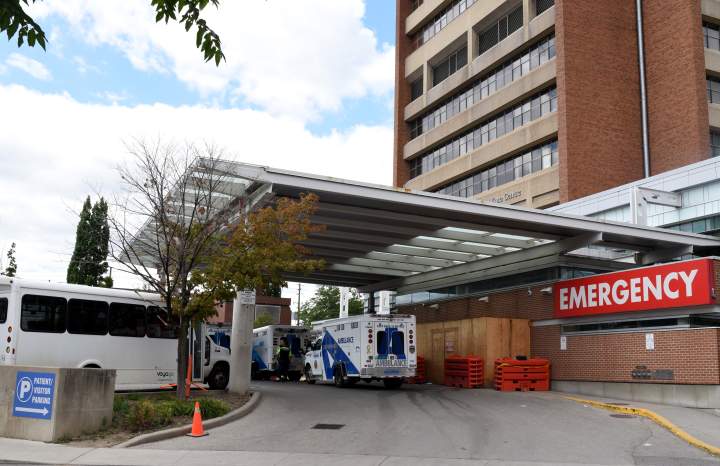
By
Teresa Wright
Global News
Published August 30, 2022
12 min read

When Simon McNeil and his wife, Pam Han, moved to rural Prince Edward Island from Toronto in 2018, they were looking for somewhere a little quieter to live.
They had no idea this decision would mean years of radio silence from the province’s patient registry — P.E.I.’s waiting list for family doctors.
“As soon as we moved here, we started looking for a family doctor, and we got on the waiting list,” McNeil said in an interview from his home in New Glasgow, P.E.I.
“At that time, we were told (the wait) was about two years. Sometime later, that estimate was changed to four years and now it’s looking more like eight.”
If the couple or their daughter gets sick or needs refills for necessary prescriptions, they must go to a walk-in clinic. But this has become almost impossible over the last two years, as clinics in P.E.I. have been filling up within minutes of opening, Han said.
The only option left for them is to take time off work and wait for hours in a hospital emergency room or pay out of pocket for a virtual health appointment — both of which the family has been forced to do over the last four years since moving to the East Coast.
“It’s certainly frustrating and also devastating,” Han said.
“We’ve become more isolated than we used to be. We don’t want to take the risk of getting sick, so we mostly just stay home.”
The P.E.I. couple is among millions of Canadians increasingly forced to seek non-urgent medical care in emergency departments due to a growing shortage of family physicians across the country.
Nearly five million Canadians over the age of 12 did not have access to a family doctor in 2019, according to the latest available data from Statistics Canada. The rates of people living in Quebec, Alberta and Nova Scotia without a primary care provider rose significantly in 2019 compared with a previous survey in 2015, but all provinces reported proportions of 10 per cent of their populations or higher in need of a family doctor.
And these numbers have likely grown, as an increasing number of family physicians across Canada have been reducing their patient loads, cutting hours or leaving family medicine altogether, according to the College of Family Physicians of Canada.
This has led to a domino effect across the health-care system in Canada, where patients who no longer have access to primary care are now getting sicker from not being able to see a doctor early on when problems arise, said Dr. Katharine Smart, a pediatrician and the outgoing president of the Canadian Medical Association.
It is also leading to non-urgent patients being funnelled into emergency rooms that are already overburdened, due to growing a shortage of health-care workers in alternative care facilities like long-term care homes, she added.
It’s one of many factors that has led to a cascade of temporary ER closures from coast to coast — a phenomenon that is putting even greater pressure on emergency departments that remain open.
Smart says hospitals across the country are dealing with an influx of patients that have limited or no access to family doctors or primary care.
“Absolutely, some of the volume that we’re seeing in the emergency department is related to the fact that many people are now having to use the emergency department as a place to access care,” Smart said.
“We really have a health system that relies on the idea of people having access to a family doctor in primary care to address their ongoing health issues and also to engage in prevention.”
Without this backbone of primary care to provide basic preventive medicine, there are now more missed diagnoses and more people with chronic conditions struggling to get care, she said.
“Some of those patients are ending up in emergency departments either to access basic care because there’s no other place in their community to get that care or because they’re presenting with more significant illness, whether it’s their own chronic illness that’s gotten worse or new diagnoses that are now presenting to the emergency department.”
Attracting new doctors to family medicine has also become more challenging. Medical students are increasingly choosing not to study family medicine, opting instead to focus on more specialty areas of medicine.
This past year, 99 family medicine residencies of the 1,569 available across Canada were left unfilled, even after a second round of hiring for new physicians for the year, according to data from the Canadian Resident Matching Service (CaRMS), the independent agency that matches medical students to residency positions in Canada.
This is just the latest in what has been a downward trend in family medicine residency match rates over the last five years, says Dr. Brady Bouchard, president of the College of Family Physicians of Canada.
“I think it should be pretty concerning to Canadians that and it certainly is to us — the inability to find a family physician to look after you over time,” Bouchard said.
“We’re not going to have enough physicians across Canada any time soon.”
The factors that have led to doctors moving away from family medicine are multidimensional, Bouchard explained.
But one of the biggest structural issues is the way family practices are run in many provinces: as a fee-for-service model, he said. This means family doctors are paid the same amount by their province for each patient visit, regardless of the severity of the case.
Not only does this create an opposite incentive for physicians — they work and get paid less if their patients are healthier — this model turns family physicians into a small-business owner who must run their own office, including hiring staff and dealing with things like commercial rents, overheard and ordering their own medical supplies.
In the past, the fee-for-service model was how most family physicians preferred their practices to run. But this is changing, Bouchard said.
“Certainly new family physicians coming into practice, the newest generation of residents, they want to focus on clinical care, they don’t want to be focusing on running a business,” he said.
“And particularly with that fee-for-service model, it makes it tough to take a break.”
Due to a shrinking pool of family physicians in Canada, there is a countrywide shortage of locums, or temporary replacements, that can fill in for family doctors if they become ill or want to take a vacation, Bouchard said, citing this as another factor in the diminishing popularity of family medicine.
“You’re basically left up to your own devices to find a replacement to come in. And if you don’t find a replacement, then all of those costs keep going on while you don’t have an income. So family physicians are burning out.”
But it’s not only a shortage of family physicians causing cracks in the system that are now leading to ER overcrowding and temporary emergency department closures.
Hospitals across the country have also been grappling with a growing number of patients occupying hospital beds who should be placed in alternative care settings, such as long-term care or home care.
But a lack of available nursing home beds or alternative care options means new patients coming to ERs must stay for extended periods in emergency departments when there is no room to admit them — a problem that has persisted in many hospitals across Canada for a number of years, Smart said.
Not only does this lead to lengthy patient stays in emergency departments — sometimes in hallways when there is nowhere else for them to go — it also leads to lengthy “offload delays” for paramedics in some provinces who must wait with their ambulance patients until they can be admitted, she said.
In Ontario, this problem has become so protracted that ambulance crews are sometimes waiting eight or 10 hours with a patient and have to be replaced by others when their shifts end, Michael Sanderson, chief of paramedic services for Hamilton and a member of the executive of the Ontario Association of Paramedic Chiefs of Ontario, told Global News in July.
This means fewer ambulances are on the road, which leads to longer wait times for people who call 911.
Kevin Smith, CEO of University Health Network (UHN), which encompasses several academic and research hospitals in Ontario, says his hospitals were “normally” operating at 110 per cent capacity before the pandemic, but due to COVID-19 backlogs of upwards of 5,000 cases, UHN capacity has had to go even higher.
“At a time when we just don’t have more staff to hire, coupled with the fact that we’re such an acute place where we have such unique programs for the sickest of Canadians … (capacity limits are) made a bit more complex by the nature of those we have the privilege of serving,” Smith said.
Currently, at least 100 patients are occupying beds in UHN hospitals that physicians have deemed less acute and should be moved to alternate settings, Smith said. But due to a shortage of staffing in places like long-term care, rehabilitation centres or home care, they remain in hospital.
The issue is nationwide. Of the 2.7 million overall acute inpatient hospitalizations in Canada in 2020-21, 5.4 per cent of these hospital stays had alternate level of care (ALC) days, according to data released earlier this year by the Canadian Institute for Health Information (CIHI). ALC days are when a patient occupies a hospital bed while waiting for more appropriate services in another care setting, such as chronic or complex continuing care, mental health or rehabilitation.
Overall, 17 per cent of days patients spent in hospitals in Canada, or more than 2.7 million days, were in alternate-level care in 2020-21, according to CIHI. And this measurement came from a year in which hospitalization rates were lower overall, which CIHI attributes to several factors due to the COVID-19 pandemic.
“That’s not good for them,” Smith said.
“Acute care hospitals aren’t great places.… Unless you need the services that are there, you’re much better off to recover in an environment with purpose-built both facilities and staff and expertise.”
This issue of aging patients and those in need of alternate care is not new.
Health systems across Canada have been grappling with how to more efficiently move patients through hospitals to stop ER overcrowding for a number of years. But the issue has become particularly acute now that it’s coupled with countrywide health worker shortages, COVID-19 backlogs and diminished availability of primary care, says Dr. Samir Sinha, director of geriatrics at Sinai Health and the University Health Network in Toronto.
Sinha says this has become an “intractable issue” because governments have not faced up to the reality that Canada has an aging population that needs a new approach to health care.
When Canada enshrined Medicare into law in 1966, it was designed to cover hospital services and primary care, but it did not include things like medications, home care or long-term care — services and interventions that would reduce the burden on hospitals if they were more widely available in the publicly funded health system, Sinha said.
“When we hear about people waiting in hospital and they’re stuck in a hospital, they can’t get home with home care, they can’t get to a rehabilitation bed, they can’t get to a long-term care bed, it’s because we actually haven’t rightsized the services we need that can keep people out of hospital in the first place,” he said.
Sinha, like others in his field, takes issue with the widely used term “bed blockers” for patients in hospitals who have nowhere else to go.
These people are being “held hostage” in hospitals as a place of last resort and should not be blamed for a system that was not designed for an aging population, he said.
Sinha and other seniors’ advocates say the solution to overcrowded hospitals is to significantly increase funding for home care and to improve compensation and working conditions for nurses.
“We have emergency rooms that are shutting down right now, not because of (alternate level of care) patients, but because we actually just don’t have the nurses and the other staff to provide that care,” he said.
One proposed solution that Sinha is concerned about is the legislation introduced earlier this month in Ontario, known as Bill 7, which would allow hospitals to send patients into long-term care homes not of their choosing — a measure Ontario is taking to deal with hospital overcrowding and ER closures.
Under this law, which hasn’t yet been passed, if a patient refuses to be moved to a “temporary” alternative home while they await space in their preferred LTC home, the province can remove them from the waiting list for long-term care, which could leave some people stranded, Sinha said.
He believes this law, if passed, takes autonomy away from seniors who have a right to determine where they will live.
“This is only going to put vulnerable people, many who have dementia, many who have a challenge advocating for themselves in more precarious situations,” Sinha said.
Other provinces, meanwhile, have been pursuing plans to increase the number of nursing homes, long-term care beds and home care supports in their jurisdictions to deal with increased pressure in acute-care hospitals from alternate-level care patients.
New Brunswick, for example, has announced plans to add 600 more nursing home beds to its system, while Winnipeg is pursuing a plan to try to keep seniors at home as long as possible before admitting them to nursing homes through home-based care.
But most of these solutions require staffing, and the Canada-wide shortage of health workers could stymie these plans, which is why Smart and other front-line health professionals say dealing with staffing issues must be the first step for all governments and health authorities when looking for solutions.
“I think there’s a lot of moral distress right now when people on the front lines are describing really how dire things are in the system and we’re hearing our leaders say things are OK,” Smart said.
“We need to get on the same page. Then we need to focus on recognizing the care that people are providing, remunerating them properly, making sure that there’s flexible work arrangements for folks so that we can bring people who’ve left the system back in.” she said. “And we really need to focus on creating a strong and safe work culture so that we can retain the medical professionals we have.”








Comments